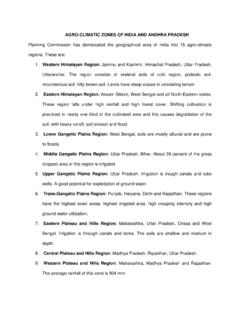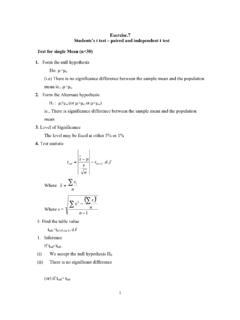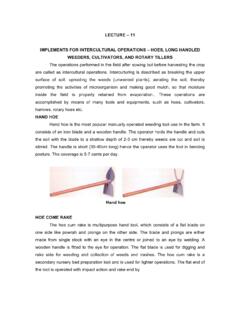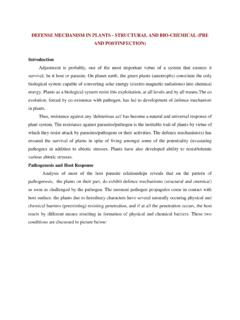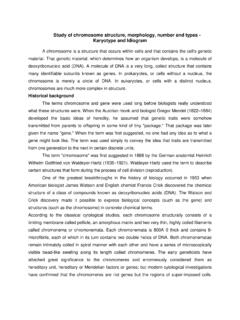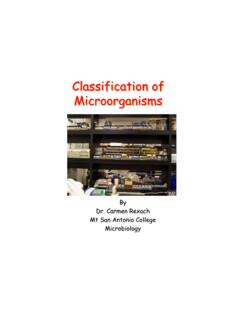Transcription of Blotting techniques
1 Blotting techniques Blotting is the technique in which nucleic acids or proteins are immobilized onto a solid support generally nylon or nitrocellulose membranes. Blotting of nucleic acid is the central technique for hybridization studies. Nucleic acid labeling and hybridization on membranes have formed the basis for a range of experimental techniques involving understanding of gene expression, organization, etc. Identifying and measuring specific proteins in complex biological mixtures, such as blood, have long been important goals in scientific and diagnostic practice. More recently the identification of abnormal genes in genomic DNA has become increasingly important in clinical research and genetic counseling.
2 Blotting techniques are used to identify unique proteins and nucleic acid sequences. They have been developed to be highly specific and sensitive and have become important tools in both molecular biology and clinical research. General principle The Blotting methods are fairly simple and usually consist of four separate steps: electrophoretic separation of protein or of nucleic acid fragments in the sample; transfer to and immobilization on paper support; binding of analytical probe to target molecule on paper; and visualization of bound probe. Molecules in a sample are first separated by electrophoresis and then transferred on to an easily handled support medium or membrane.
3 This immobilizes the protein or DNA fragments, provides a faithful replica of the original separation, and facilitates subsequent biochemical analysis. After being transferred to the support medium the immobilized protein or nucleic acid fragment is localized by the use of probes, such as antibodies or DNA, that specifically bind to the molecule of interest. Finally, the position of the probe that is bound to the immobilized target molecule is visualized usually by autoradiography. Three main Blotting techniques have been developed and are commonly called Southern, northern and western Blotting .
4 Southern blot Southern blot is a method used to check for the presence of a DNA sequence in a DNA sample. The method is named after its inventor, the British biologist Edwin Southern. The procedure for Southern blot technique is as detailed below: Restriction endonucleases are used to cut high-molecular-weight DNA strands into smaller fragments, which are then electrophoresed on an agarose gel to separate them by size. If the DNA fragments are larger than 15 kb, then prior to Blotting , the gel may be treated with an acid, such as dilute HCl, which depurinates the DNA fragments, breaking the DNA into smaller pieces, thus allowing more efficient transfer from the gel to membrane.
5 If alkaline transfer methods are used, the DNA gel is placed into an alkaline solution (containing NaOH) to denature the double-stranded DNA. The denaturation in an alkaline environment may improve binding of the negatively charged DNA to a positively charged membrane, separating it into single DNA strands for later hybridization to the probe and destroys any residual RNA that may still be present in the DNA. A sheet of nitrocellulose (or nylon) membrane is placed on top of (or below, depending on the direction of the transfer) the gel. Pressure is applied evenly to the gel (either using suction, or by placing a stack of paper towels and a weight on top of the membrane and gel), to ensure good and even contact between gel and membrane.
6 Buffer transfer by capillary action from a region of high water potential to a region of low water potential (usually filter paper and paper tissues) is used to move the DNA from the gel on to the membrane; ion exchange interactions bind the DNA to the membrane due to the negative charge of the DNA and positive charge of the membrane. The membrane is then baked in a vacuum or regular oven at 80 C for 2 hours or exposed to ultraviolet radiation (nylon membrane) to permanently attach the transferred DNA to the membrane. The membrane is then exposed to a hybridization probe a single DNA fragment with a specific sequence whose presence in the target DNA is to be determined.
7 The probe DNA is labelled so that it can be detected, usually by incorporating radioactivity or tagging the molecule with a fluorescent or chromogenic dye. After hybridization, excess probe is washed from the membrane and the pattern of hybridization is visualized on X-ray film by autoradiography in the case of a radioactive or fluorescent probe, or by development of colour on the membrane if a chromogenic detection method is used. Hybridization of the probe to a specific DNA fragment on the filter membrane indicates that this fragment contains DNA sequence that is complementary to the probe.
8 The transfer step of the DNA from the electrophoresis gel to a membrane permits easy binding of the labeled hybridization probe to the size-fractionated DNA. Southern blots performed with restriction enzyme-digested genomic DNA may be used to determine the number of sequences ( , gene copies) in a genome. A probe that hybridizes only to a single DNA segment that has not been cut by the restriction enzyme will produce a single band on a Southern blot, whereas multiple bands will likely be observed when the probe hybridizes to several highly similar sequences ( , those that may be the result of sequence duplication).
9 Modification of the hybridization conditions (ie, increasing the hybridization temperature or decreasing salt concentration) may be used to increase specificity and decrease hybridization of the probe to sequences that are less than 100% similar. Northern blot The northern blot technique is used to study gene expression by detection of RNA (or isolated mRNA) in a sample. With northern Blotting it is possible to observe cellular control over structure and function by determining the particular gene expression levels during differentiation, morphogenesis, as well as abnormal or diseased conditions.
10 This technique was developed in 1977 by James Alwine, David Kemp and George Stark at Stanford University. Northern Blotting takes its name from its similarity to the first Blotting technique, the Southern blot. The major difference is that RNA, rather than DNA, is analyzed in the northern blot. Procedure The Blotting procedure starts with extraction of total RNA from a homogenized tissue sample. The mRNA can then be isolated through the use of oligo (dT) cellulose chromatography to maintain only those RNAs with a poly(A) tail. RNA samples are then separated by gel electrophoresis.
